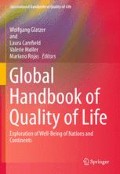Abstract
The development of mankind can be regarded as an ongoing struggle for a better quality of life and greater wellbeing. However – as far as we can see – there is always the drawback of different forms of negative wellbeing such as various worries and pain. A global view of the world’s people shows they partly enjoy life and partly suffer; many do both at the same time. It seems each age is characterized by a specific pattern of gratifying and satisfying traits, but also by a typical burden of worries and pain. It is inevitable in a globalized world that people share worldwide worries more than they did before. The bright side of life is always complemented by a dark side and worries and pain are excluded only in the idea of paradise. Common experience is that everyday disturbances as well as natural catastrophes and political disorganization are ongoing causes of worries and pain. Avoiding negative wellbeing and increasing positive wellbeing, together with expectations of a good future, are important contributors to the comprehensive wellbeing of people.
For friendly support to elaborate this article I want to say thank you to Jennifer Gulyas and Ruth Hasberg.
Access this chapter
Tax calculation will be finalised at checkout
Purchases are for personal use only
Notes
- 1.
In the available global materials I could not find measures of the depth and strength of worries and pain. It could be that the perceived depth and strength of worries and pain differs between different countries and population groups.
- 2.
The questions reflecting positive feelings are:
-
Pleased about having accomplished something?
-
That things were going your way?
-
Proud because someone complimented you on something you had done?
-
Particularly excited or interested in something?
-
On top of the world?
-
- 3.
The number of countries included and the representation of the continental countries:
-
Nine from Africa, distribution from the North to the South with big gaps in between;
-
Fifteen from Asia, including China and Russia, some of South East Asia but not India;
-
Twenty from Europe, only small countries are missing, mostly from the Baltic;
-
Eleven from America, including all big countries of the North, the Middle and the South;
-
Two from Australia; namely Australia and New Zealand but not Oceania (not the Arctic and not Antarctica).
-
This is not an exact representation of the world, its countries and its population, but it is the best representation which we can get today.
-
References
American Psychiatric Association. (1987). Diagnostic and statistical manual of mental disorders. Washington, DC: American Psychiatric Association.
Anderson, R. (2011, May 13). World suffering – Conceptualization, measurement and findings. Paper presented at the 2011 annual meetings of the American Association for Public Opinion Research (AAPOR) in Phoenix, Arizona.
Andrews, F. M., & Withey, S. B. (1976). Social indicators of wellbeing. Americans perceptions of life quality. New York: Plenum Press.
Boehnke, K., et al. (1998). The structure and dynamics of worry: Theory, measurement, and cross-cultural replications. Journal of Personality, 66, 745–782.
Bradburn N. M. (1969). The Structure of Psychological Well-being. Chicago: Aldine
Campbell, A., Converse, P. E., & Rodgers, W. L. (1976). The quality of American life. New York: Russell Sage Foundation.
Cantril, H. (1965). The pattern of human concerns. New Brunswick: Rutgers University Press.
Castrillon, P. (2013). Modernisierung und soziale Konflikte in Kolumbien. Inaugural dissertation, Goethe Universität Frankfurt am Main.
Gallup International Research Institute (Ed.). (1978). Interview with humanity. Human needs and satisfactions: A global survey. Basel: Baloise Insurance Group.
Gallup World Poll. (2010). www.gallup.com. 15 Dec 2011.
Glatzer, W. (2011). Cross-national comparisons of quality of life in developed nations, including the impact of globalization. In K. Land (Ed.), Handbook of social indicators and quality of life research. Dordrecht: Springer.
Glatzer, W., & Gulyas, J. (2014). Wellbeing and illbeing: Names and naming. In Encyclopedia of quality of life research. New York: Springer.
Glatzer, W., & Zapf, W. (Eds.). (1984). Lebensqualität in der Bundesrepublik. Objektive Lebensbedingungen und subjektives Wohlbefinden. Frankfurt am Main/New York: Campus.
Helliwell, J., Layard, R., Sachs, J. (Ed.). (2012). World happiness report. http://earth.columbia.edu/sitefiles/file/Sachs%20Writing/2012/World%20Happiness%20Report.pdf. 2 Oct 2012.
HSBC. (2010). Climate conference monitor 2010. http://www.hsbc.com/1/PA_1_1_S5/content/assets/sustainability/101026_hsbc_climate_confidence_monitor_2010.pdf. 25 Oct 2011.
Meyer, T. J., Miller, M. L., Metzger, R. L., & Borkovec, T. D. (1990). Development and validation of the Penn State Worry Questionnaire. Behaviour Research and Therapy, 28(6), 487–495.
Pompili, M. (2012). Suicide: A global perspective. E-book, Rome
Schwartz, S. H., & Melech, G. (2000). National differences in micro and macro worry: Social, economic, and cultural explanations. In E. Diener & E. M. Suh (Eds.), Culture and subjective Wellbeing. Cambridge: MIT Press.
Tallis, F., Eysenck, M., & Mathews, A. (1992). A questionnaire for the measurement of nonpathological worry. Journal of Personal and Individual Differences, 13(2), 161–168.
Veenhoven, R. (2012). World database of happiness. http://worlddatabaseofhappiness.eur.nl/
Veroff, J., Douvan, E., & Kulka, R. A. (1981). The inner American: A self-portrait from 1957 to 1976. New York: Basic Books. Page in report 54.
Warr, P. A. (1978). Study of psychological wellbeing. The British Journal of Psychology, 6, 111–121.
Word Value Survey Wave 5. (2005–2008). http://www.jdsurvey.net
Author information
Authors and Affiliations
Corresponding author
Editor information
Editors and Affiliations
Rights and permissions
Copyright information
© 2015 Springer Science+Business Media Dordrecht
About this chapter
Cite this chapter
Glatzer, W. (2015). Worries and Pain – The Dark Side of Quality of Life. In: Glatzer, W., Camfield, L., Møller, V., Rojas, M. (eds) Global Handbook of Quality of Life. International Handbooks of Quality-of-Life. Springer, Dordrecht. https://doi.org/10.1007/978-94-017-9178-6_40
Download citation
DOI: https://doi.org/10.1007/978-94-017-9178-6_40
Published:
Publisher Name: Springer, Dordrecht
Print ISBN: 978-94-017-9177-9
Online ISBN: 978-94-017-9178-6
eBook Packages: Humanities, Social Sciences and LawSocial Sciences (R0)

